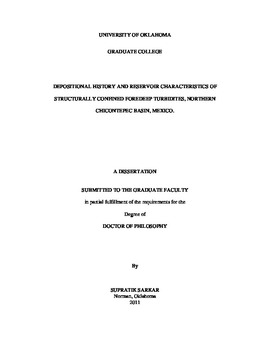| dc.contributor.advisor | Marfurt, Kurt J.||Slatt, Roger M. | |
| dc.creator | Sarkar, Supratik | |
| dc.date.accessioned | 2019-06-03T20:35:28Z | |
| dc.date.available | 2019-06-03T20:35:28Z | |
| dc.date.issued | 2011 | |
| dc.identifier | 99174310202042 | |
| dc.identifier.uri | https://hdl.handle.net/11244/320202 | |
| dc.description.abstract | Turbidite deposits within structurally confined and tectonically active basins often exhibit complex sediment distribution patterns and facies relationships. In this dissertation, I concentrate on unraveling the deepwater depositional history of the Chicontepec foreland basin followed by characterizing the turbidite reservoirs resulting from the complex depositional process and later affected by extensive diagenesis and volcanic emplacement. I augment this study with a seismic geomorphologic analysis of turbidites of a tectonically dynamic salt minibasin in the Gulf of Mexico and establish its relationship with sequence stratigraphy and sea level changes. | |
| dc.description.abstract | One of the key contributions of this dissertation is the reconstruction of the geologic history of the complex north Chicontepec basin turbidites, which represent one of the most important hydrocarbon plays in Mexico. I integrated seismic geomorphology, outcrop information, well log and core interpretation and tied with geologic time and tectonic history to unravel the progressive changes in depositional patterns and facies | |
| dc.description.abstract | associations. The Chicontepec reservoir interval is subdivided into stratigraphic units equivalent to global 3rd order sequences. Based on those subdivisions, I propose a new depositional history model for the northern Chicontepec basin which is comprised of two major flow components from different directions and their variable interactions through geologic time with changes in basin floor geometry. The changes in depositional pattern are broadly correlated with the changes in reservoir quality. | |
| dc.description.abstract | Chicontepec turbidites are characterized by unique rock types containing | |
| dc.description.abstract | abundant carbonate rock fragments with quartz, feldspar and clay. Chicontepec deposition was followed by complex diagenetic processes inducing extensive cementation resulting in the low porosity, low permeability Chicontepec Sandstone. A key aspect of this dissertation is to illustrate a simple and effective methodology to characterize the complex Chicontepec reservoir interval and outline prospective areas for | |
| dc.description.abstract | further hydrocarbon exploration. Correlating the stratigraphic units to producing and nonproducing intervals provided the link between rock properties and different Chicontepec reservoir zones. These links provide the means to map the potential reservoir zones from prestack inversion-driven rock property volumes. | |
| dc.description.abstract | I also evaluate the potential effect of volcanic bodies on the adjacent Chicontepec reservoir intervals. Volcanic bodies are an integral part of Chicontepec petroleum system. I study their interactions with the Chicontepec sediments from the outcrop and well log patterns in a seismic geomorphologic framework. I propose a dual porosity model and | |
| dc.description.abstract | map the potential zones within the Chicontepec Formation with predicted enhanced permeability by the influence of shallow volcanic bodies. | |
| dc.format.extent | 182 pages | |
| dc.format.medium | application.pdf | |
| dc.language | en_US | |
| dc.relation.requires | Adobe Acrobat Reader | |
| dc.subject | Turbidites--Mexico--Chicontepec | |
| dc.subject | Submarine geology--Mexico--Chicontepec | |
| dc.title | DEPOSITIONAL HISTORY AND RESERVOIR CHARACTERISTICS OF STRUCTURALLY CONFINED FOREDEEP TURBIDITES, NORTHERN CHICONTEPEC BASIN, MEXICO. | |
| dc.type | text | |
| dc.type | document | |
| dc.thesis.degree | Ph.D. | |
| ou.group | Mewbourne College of Earth and Energy::ConocoPhillips School of Geology and Geophysics | |
